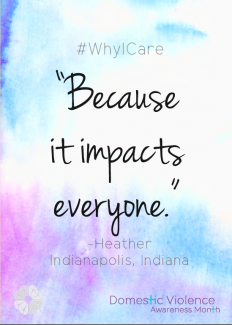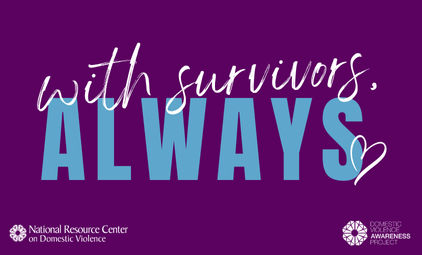by Ivonne Ortiz, Training & Education Specialist for the National Resource Center on Domestic Violence
With Domestic Violence Awareness Month (DVAM) behind us, the question is: how can we motivate our communities to stay involved? Domestic violence awareness goes beyond a purple ribbon and a powerful speech. It’s more than the poster, the walk, and the candlelight vigil. Domestic violence awareness is the ability to change people’s mindsets about its very nature and impact on all of us, and to inspire passion for social change long after DVAM comes to an end.
While individuals and families are devastated by domestic violence, its impact on entire communities runs even deeper. That is why it is so important to keep the conversation going throughout the year. According to Futures Without Violence, community engagement is one of the keys to preventing domestic violence. This means that the steps we take today to engage our communities and change cultural norms and institutions are necessary to move us closer to preventing gender-based violence tomorrow.
Back in the 90’s, I was the volunteer coordinator for a local domestic violence program. As you can imagine, this task was a hard one, but I believed in the cause and wanted to make a difference. I quickly realized that I was in over my head. Community engagement was not an easy task. With time, I understood that the most successful engagement strategy is the one that brings together the talents, resources and skills of people in the community.
This “collection of awesomeness” is what increases a community’s collective power to engage in social change, and that was our ultimate goal.
After many failed attempts, I was able to make important connections with key members of the community. As a result, domestic violence awareness became more than a purple ribbon during the month of October. It became more about the community supporting survivors and holding perpetrators accountable. It became more about changing individual’s attitudes and beliefs about gender-based violence.
I also learned that November is the perfect time to reach out to your community. Why? Well, because you have already taken the first step of a successful engagement strategy: awareness. Through local, statewide and national DVAM events and campaigns, awareness is heightened around the issue. These events most likely brought the dialogue about violence in the home into public consciousness.
Now, since awareness does not by itself lead to action, we have to find ways to encourage the community to actively support your program. This is one of the most tangible, invaluable ways to help end domestic violence. As you know, domestic violence programs can greatly benefit from the community’s commitment, empathy, and help, especially in the form of donations or volunteer time.
Promoting your program and its mission to potential volunteers requires that your passion for the movement become contagious. Your energy and excitement for social change has to motivate a person to want to join. Think of ways to explain why your volunteer program is most worthy of their time and energy. An example can be that their efforts will eventually lead to social change, which specifically draws on the DVAM message “Awareness + Action = Social Change.”
It’s also important to develop an “elevator pitch.” An elevator pitch is a brief and very persuasive speech that you use to spark interest in what your program does. The elevator pitch should be no longer than 30 seconds, and should answer:
- What is your message? Why do you care?
- Why should they care? Why should someone volunteer for your program?
Modify the length and content of your pitch for each potential volunteer. Remember the same message won’t work for everyone.
You can find additional ideas for engaging your community in the flyer 13 Ways Any Adult Can Make Ending Domestic Violence His or Her Business. The Special Collection, Open Doors: Thinking Beyond Shelter (Or Alternative Ways to Help Survivors) also provides great resources and ideas for engaging the community into becoming a part of the solution.
Can you share creative ways to engage communities?















